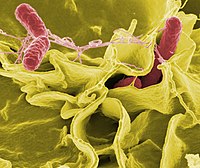
Photo from wikipedia
Abstract National one health monitoring programs for antimicrobial-resistant enteric pathogens often include Escherichia coli as a sentinel for resistance to antimicrobials with Gram-negative activity. The purpose of this study was… Click to show full abstract
Abstract National one health monitoring programs for antimicrobial-resistant enteric pathogens often include Escherichia coli as a sentinel for resistance to antimicrobials with Gram-negative activity. The purpose of this study was to investigate if antimicrobial resistance for E. coli can predict resistance in Salmonella when they occur together in the same surveillance sample of raw retail meat or food animal cecal contents collected by the National Antimicrobial Resistance Monitoring System (NARMS). One colony of each bacterium was isolated from each culture-positive sample and assayed for antimicrobial susceptibility by broth microdilution using the standard NARMS panel of 14 antimicrobial agents. A total of 1305 raw retail meats and 348 slaughter animal cecal samples contained both bacteria. Likelihood ratios were used to assess the extent to which antimicrobial resistance in E. coli coincides with resistance in Salmonella from the same sample. Results showed that for 8 out of 10, and 5 out of 10 antimicrobials tested in retail meat and cecal respectively, there was a statistically significant increase in the probability of finding Salmonella resistant to a particular antimicrobial when E. coli from the same sample was resistant to the same drug. Among those 8 and 5, likelihood ratios show that E. coli resistant predicted Salmonella resistance to ceftriaxone, ceftiofur, cefoxitin, and amoxicillin-clavulanic acid in retail meat, and to gentamicin, ceftriaxone and amoxicillin-clavulanic acid in cecal samples. Although E. coli is used as a sentinel for integrated antimicrobial resistance surveillance, these results suggest that E. coli may have limited value as the sole predictor of antimicrobial resistance in Salmonella except for beta lactams antimicrobials.
Journal Title: Food Control
Year Published: 2020
Link to full text (if available)
Share on Social Media: Sign Up to like & get
recommendations!